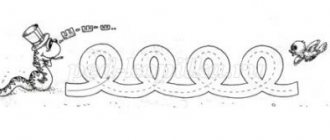How sound is produced
When pronouncing [T], the articulatory organs are in the following position: the lips stretch slightly, the teeth open, the tip of the tongue connects with the upper incisors, the air stream is sharp, breaks the bow, there is no voice.
In the initial position, the lips should open slightly, the gap between the dental rows is approximately 3-5 mm. The tip of the tongue hits the upper alveolar process, connecting with it. When playing [T], the soft palate rises, the vocal folds separate, and the air flow is jerky. The sound [T] is consonant, hard, occlusive, anterior lingual, explosive, noisy, deaf.
Diagnosis of pronunciation D
Due to the immaturity of the articulatory apparatus in childhood, the sound D may be confused with other sounds: , or even .
The following defects are encountered when pronouncing D:
- Deafening: D - T. The reason for deafening is that articulation with D is similar to the sound T, and as a result of insufficient formation of phonemic perception or defective development of the speech apparatus as a whole, the sound is replaced by a voiceless paired T. The defect is eliminated with the help of the phoneme B. In this In this case, it is necessary to start producing the sound from the word BA. We say BA-BA quickly, without pausing. We lift the tongue up, it continues to work BA-DA, BA-DA. Now D becomes more sonorous, and in the end we get YES-YES-YES.
- The open nasality of D-N. The velum is slightly lowered, the tip of the tongue is passive, there are no jerky air flows from the mouth, only a continuous stream of air from the nasal cavity. It is necessary to eliminate the transmission of the air stream through the nose, and direct the air through the mouth. The air stream should come explosively, in jerks.
- Clicking D. Work in the same ways as with defects 1 and 2, achieving the movement of the air stream in jerks through the oral cavity.
To identify deficiencies in the sound pronunciation of D, a small diagnostic test should be performed.
- When pronouncing sentences where D occurs quite often, ask the child to repeat what he heard. You can take the following phrase: Dasha gave Dana a pipe.
- Show your child several pictures depicting objects or living objects whose names begin with D or D. Then the child says what is shown in the illustrations. You can take pictures with drawn: children, house, woodpecker, board, etc.
- Pictures are laid out on the table. The adult asks to find, show and name any of them. All drawings depict objects with names starting from D-D.
Defects in the pronunciation of the sound [T]
- Distortion . Instead of [T], a sound is heard that has no analogue in the native language. Nasal pronunciation of phonemes in rhinolalia.
- Absence (elision) . The articulatory structure of the phoneme is not completely formed. Occurs in severe forms of cleft palate in the case of rhinolalia.
- Replacement . [T] is replaced by another phoneme, similar in acoustic-articulatory parameters, most often by the back-lingual phoneme [K]. With rhinolalia, a replacement with pharyngeal pronunciation is observed.
- Mixing . In isolation [T] is pronounced correctly, but in spontaneous speech it is replaced by another phoneme.
- Mitigation . Replacement of hard [T] with soft [Ть], undifferentiated use of these phonemes.
- Vocalization defect . The child does not deafen the sound enough. His sonorous pair [D] can be heard in his speech.
Causes of impaired pronunciation D-D
The most common reasons why a child is unable to pronounce D-D are:
- poor articulation of speech organs;
- phonemic hearing is not developed (the baby does not even distinguish sounds);
- a bad example of sound pronunciation (if someone nearby pronounces sounds incorrectly, lisps “childishly”);
- poor motor activity of the jaw, problems with the development of the speech apparatus (for example, with dysarthria).
In any case, it is necessary to undergo a speech therapy examination by a specialist if any disturbances with the sound D are noticeable.
Preparatory stage for sound production [T]
Speech therapy work on the production of any sound traditionally contains four stages: preparatory, actual production, automation, differentiation. The lesson begins with the characteristics of articulation. Be sure to use a variety of visual material: picture plan, articulation profiles, manual articulation model, dummies, pictures.
The child examines the position of the articulatory organs and determines the nature of the air flow. Then, with the help of an adult, he analyzes the sound according to the following algorithm: vowel or consonant (whether there is an obstacle to the exhaled air flow), dull or voiced (whether the vocal cords tremble), hard or soft (whether the middle part of the back rises to the hard palate).
After becoming familiar with the characteristics of sound, you need to start performing articulatory gymnastics:
- Fence. The teeth are clenched tightly, the lips stretch into a wide smile. Hold this position for about ten seconds.
- Arrow. The front edge of the tongue moves very quickly to the left and right from one corner of the lips to the other.
- Flatbread. The spread out wide tongue is located on the relaxed lower lip.
- Naughty tongue. Open your mouth as much as possible. Place your flat tongue on your lower lip and say “five-five-five” while slapping your upper lip.
- The escape. Push your tongue between your closed teeth.
- Brush. Use the narrow tip of the tongue to make sliding movements along the upper incisors, moving to the alveolar processes.
- Camel. Suck up the candy with the tip of your tongue, click at the same time, then spit out the candy with the wide tip.
In addition to articulation exercises, gymnastics involves performing breathing exercises:
- Football player. Open your mouth very strongly, pull out the flat tip of your tongue, and with a sharp exhalation, blow a light ball into the toy gate.
- Sailor. Using jerky short exhalations, push the paper boat into a container of water.
Correct articulation of the sound D
- Lips in a neutral position, completely relaxed. The gap between the incisors and lips is approximately 4-5 mm. Depending on the vowel following D, the placement can be adjusted.
- The tip of the tongue rests on the upper part of the palate, touching the alveoli (these are small tubercles behind the upper row of front teeth).
- Lower the soft part of the palate.
- Cause vibration of the larynx.
- Close the vocal folds, add a little voice.
After working with articulation, we begin sound production. We start with preparatory classes, including articulation and breathing exercises.
Setting the sound [T] with a softening defect
Soft phonemes are characterized by a high elevation of the back of the tongue towards the hard palate. The softening defect appears due to increased muscle tone. The nature of the defect is influenced by the location of the lesion in the cerebral cortex.
An increase in the muscle tone of the tongue causes it to tense, pull back, and the tip is not pronounced. To eliminate this disorder, speech therapy exercises are used: hill, angry cat, frog. Their goal is to ensure plasticity of the middle part. In difficult situations, you should rely on tactile sensations - place your middle and index fingers on your tongue to feel relaxation when moving from a soft sound to a hard one.
It is necessary to demonstrate the difference in the position of the tongue in front of the mirror and ask to repeat the position. Then the child reproduces paired syllables with hard and soft phonemes after the adult. If the solid sound is reproduced correctly, it is advisable to immediately begin pronouncing words.
Basic moments
The sequence of sounds may vary. Some experts suggest starting with vowels, then moving on to consonants. Chirkina recommended starting with the group for which the articulatory apparatus is ready.
To start making the sound “Ш” for dysarthria or others, you need to complete several tasks. Their goal is to prepare the ground for work.
Parents should prepare for the fact that it will take months of work to eliminate the violation.
The specialist is engaged in the development of:
- hearing;
- breathing;
- speech organs.
It is these three components that provide the basis for the pronunciation of certain sounds. Without them, the child will not hiss or whistle, not to mention growl.
Classes in kindergarten are conducted both in groups and individually. To increase work efficiency, parents also work at home to consolidate certain skills.
Setting the sound [T] for dysarthria
Several methods of setting [T] are used:
- Spitting. It is considered the most effective staging technique. Against the background of the involuntary movement of spitting, they achieve the sound [T] by clamping the edge of the tongue with the incisors, then moving it behind the upper teeth with a spatula.
- Production of [T] by imitation of the syllable TA. An adult in front of a mirror invites the child to pronounce first the syllables, and then the words, with the syllable TA. Then pure phrases are spoken. You can use ready-made sayings, or come up with new ones together with your child.
- Interdental method. The adult demonstrates the position of the tongue to the child. Starting position - the tongue is located behind the teeth and pressed tightly with the jaws on both sides. In this position, you need to take a deep breath and exhale sharply to produce sound. Having achieved interdental sound, move your tongue behind your teeth.
- Stun. Stun [D] - say in a whisper.
- From the sound [P]. [T] is developed as a derived phoneme from [P]. Begin with several repetitions of the syllable PA, pressing the widest part of the tip of the tongue to the lower lip. Then you need to pronounce the original syllable while smiling, and you should hear TA-TA.
- Mechanically from the syllable PA. The tip of the tongue is in an interdental position, set against the background of [P]. It is necessary to reproduce the syllable PA repeatedly, at the same time the lips are parted with the help of the thumb and forefinger. If performed correctly, the syllable TA should be heard.
Automation and differentiation of sound [T]
After the child has been able to correctly pronounce [T], it is necessary to move on to automating it - reinforcing the correct pronunciation. Automation should begin with the development of phonemic hearing - the perception of phonemes by ear. The child is asked to isolate a sound from a number of phonemes that are similar in acoustic-articulatory characteristics; isolate it from a series of syllables; isolate a sound from a series of words; determine its presence and location in a word. At the beginning of automation and with an insufficient level of speech development, it is necessary to start with sounds that are distant in acoustic-articulatory characteristics.
Then they move on to automating the phoneme in isolated form. It is practiced with a sharp exhalation using onomatopoeic games.
Then you need to introduce the child to the letter that represents the sound [T] in the letter. Explain how a sound differs from a letter: a sound is heard and spoken, but a letter is seen, written and read. They select objects from the surrounding world that look like the letter T.
If necessary, the correct spelling of the letter is practiced. A variety of graphic exercises are used, aimed at developing hand motor skills and training in obtaining an adequate image of a letter. When a child speaks the sound [T] well in isolation, the automation of phonemes in syllables, in words, in sentences, in coherent speech begins.
After automating the sound, they move on to its differentiation - distinguishing it from other sounds. It is carried out by analogy with automation: in isolation, in syllables, words, sentences, coherent speech. First, sounds that are distant in acoustic-articulatory characteristics are differentiated, ending with phonemes that have similar sound and articulation. The production of the sound [T] is considered complete if the child always pronounces [T] accurately, including in spontaneous speech.
History of the letter D
The Church Slavonic name for this letter is “good”.
The appearance of the letter D is borrowed from a Greek letter called delta, which looks like a triangle. Only the printed Greek version has no legs.
But in the letter the paws are drawn.
Some people wonder why the printed letter D has two legs, but only one tail is written down on the letter.
This happened somewhere in the 14th-17th centuries. Then the formation of cursive writing began in the Russian language. And the letters of the alphabet began to lose some of their graceful elements.
This happened with lowercase D. It became slightly rounded, its curls fell off, and instead a tail-loop grew from below.
It is interesting that in the manuscripts of that time, when the formation of the written letter D was just being improved, two tails were observed at once: above and below. But drawing such a miracle was not in the rules of cursive writing, so they decided to cut off the upper tail once and for all.
So the letter acquired the form to which we are accustomed now.
And in the 18th century, Peter the Great, the letter D with one tail at the bottom was officially approved. The reason for this decision was that the two lower legs of the letter D seemed to remain, they were simply connected into a loop.
The option with an upper ponytail also remained in use. They began to choose: either the lower ponytail or the upper one.
It was the writing of the letter D with an upper loop tail that was popular among highly educated people. Leo Tolstoy wrote the letter D with an upper loop.
Ordinary people quickly switched to D with a lower loop.
The letter B occupies the second place of honor in the Russian alphabet. In the Glagolitic alphabet it corresponds to the numerical value 2.
In the Church and Old Church Slavonic alphabet it is called “buki” or “buki”, which translated means “letter”.
The letter D is the fifth from the beginning, twenty-ninth from the end of the alphabet and refers to paired voiced consonants. Its pair sound [T] is a voiceless consonant.
At the beginning of a word and in the middle, the letter D sounds loud, and at the end of the word it is deafened, so that its paired sound T is already heard.
Example: tree - bucket - vegetable garden. In the last word we hear T instead of D.
In the Church and Old Slavonic alphabet it is called “Good”.
She came to the Cyrillic alphabet from Byzantium, where her friend “delta” was written “paws down”, like the modern letter D.





